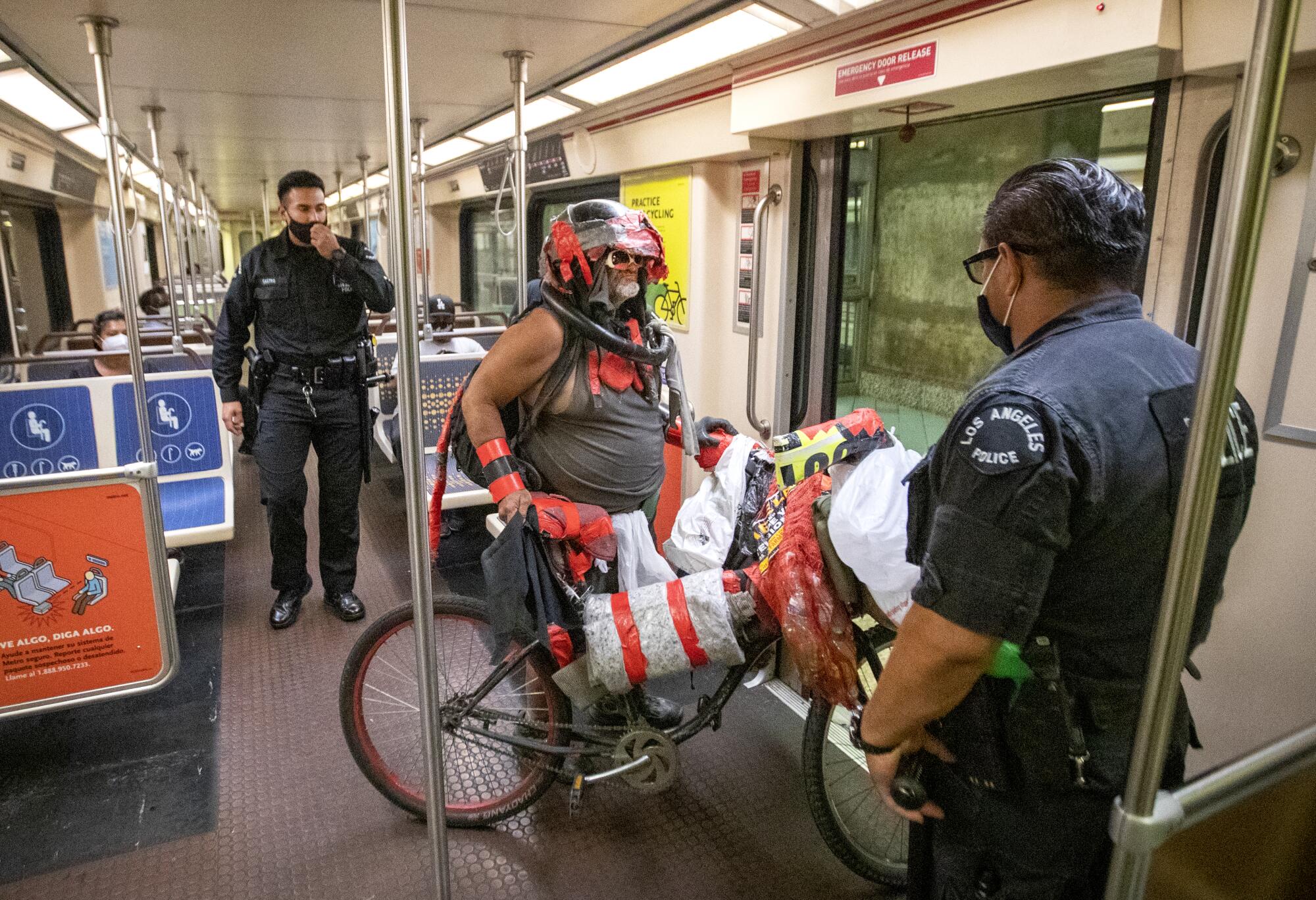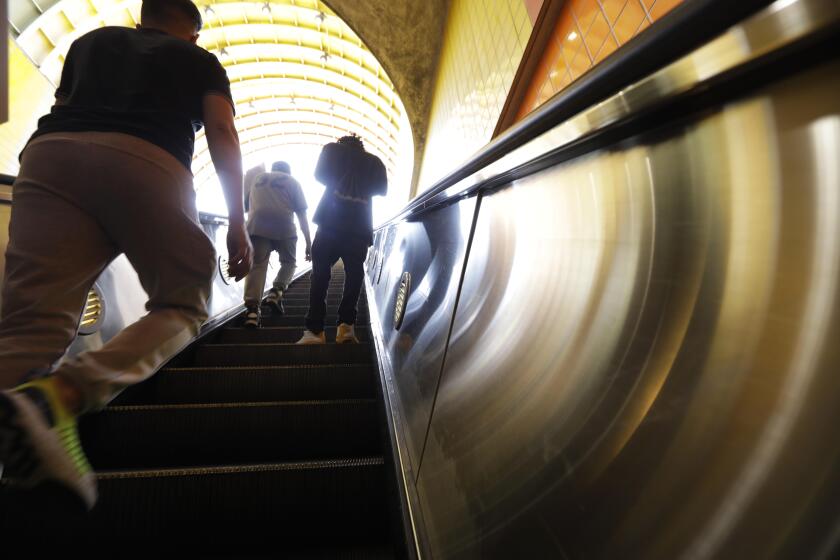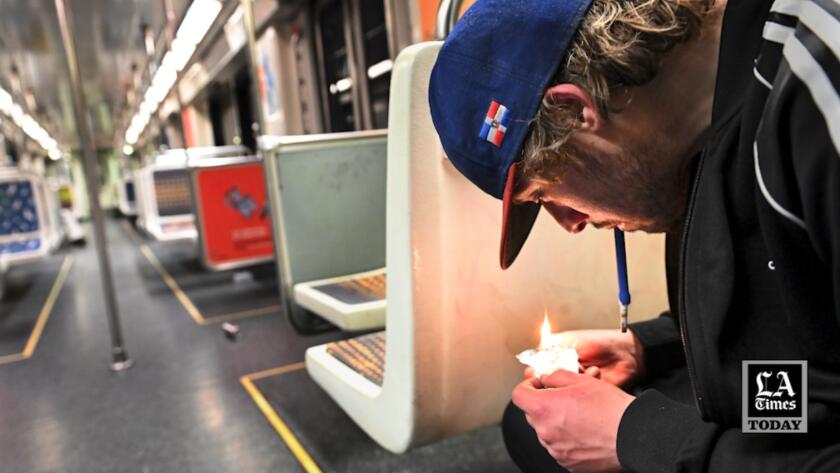
- Share via
Matthew Morales boarded the Metro Red Line at MacArthur Park as classical music blared over the station loudspeakers.
It was rush hour on a Tuesday afternoon, and Morales made his way to a back corner seat and unfolded a tiny piece of foil with several blue shards of fentanyl. As the train started west, he heated the aluminum with a lighter and sucked in the smoke through a pipe fashioned from a ballpoint pen.
Doors opened and closed. A few passengers filed in and out. A grain of the opioid fell to the floor. He concentrated on trying to pick it up, then lost track, as his body went limp. His shoulders slumped and he slowly keeled forward.
By the time the train arrived at the Wilshire/Western station, Morales, 29, was doubled over and near motionless, his hand on the floor. The train operator walked out of the cabin, barely glancing at him as she passed — as if she encountered such scenes all the time.

Drug use is rampant in the Metro system. Since January, 22 people have died on Metro buses and trains, mostly from suspected overdoses — more people than all of 2022. Serious crimes — such as robbery, rape and aggravated assault — soared 24% last year compared with the previous.
“Horror.” That’s how one train operator recently described the scenes he sees daily. He declined to use his name because he was not authorized to talk to the media.
Earlier that day, as he drove the Red Line subway, he saw a man masturbating in his seat and several people whom he refers to as “sleepers,” people who get high and nod off on the train.
“We don’t even see any businesspeople anymore. We don’t see anybody going to Universal. It’s just people who have no other choice [than] to ride the system, homeless people and drug users.”
Commuters have abandoned large swaths of the Metro train system. Even before the pandemic, ridership in the region was never as high as other big-city rail systems. For January, ridership on the Gold Line was 30% of the pre-pandemic levels, and the Red Line was 56% of them. The new $2.1-billion Crenshaw Line that officials tout as a bright spot with little crime had fewer than 2,100 average weekday boardings that month.

Few stations compare with MacArthur Park/Westlake. The station sits next to an open-air drug market that’s existed in this dense immigrant neighborhood for decades. About 22,000 people board the trains here daily.
The Los Angeles County Metropolitan Transportation Authority reported that between November and January there were 26 medical emergencies at the station, the majority of them suspected drug overdoses. Last year, there were six deaths and one shooting, nearly all related to suspected drug activity. Earlier this year, a 28-year-old man was fatally stabbed in a breezeway of the station.
Metro reports there were as many deaths on its system since Jan. 1 as there were all last year. Crime and drug use are causing some officials to call for increased security.
Maintenance crews are often called out for repairs at the station, and when they return to their vehicle they often find it has been burglarized. Gangs control the area and police say many of the informal vendors on the sidewalks are part of the larger drug economy, wittingly or not. Some are forced to pay the gang taxes, others sell stolen property.

The transit agency’s head of security has said she will be asking the 13-member board — that includes Mayor Karen Bass and the county supervisors — to expand the agency’s force of nearly 200 in-house transit officers, some of whom are armed and enforce fare evasion and code of conduct violations. And the board will soon decide whether to continue contracts with the Los Angeles Police Department, the Los Angeles County Sheriff’s Department and the Long Beach Police Department, or come up with another way to secure the system.
Some board members and social justice advocates have argued for less policing on the system, saying that racial profiling targets many passengers.
“What will harassment and jailing people who use drugs do to address drug use rates?” said Alison Vu, a spokesperson for the Alliance for Community Transit-LA, a social justice advocacy coalition that wants the agency to eliminate contracts with law enforcement. “We’ve poured so much money into policing, without any measurable impact on care or safety for transit riders.”
Can transit officials make buses and trains safer without more police? A new program will put 300 unarmed ambassadors as violence rises on the system.
In response to such concerns, transit officials committed $122 million over the last year trying to make the system — composed of 105 rail stations and more than 12,000 bus stops — feel safer by placing 300 unarmed “ambassadors” to report crimes and help passengers. It’s part of what officials like to tout as a “multilayered” approach to improving a system that’s become emptier and more dangerous over recent years — even as billions have been sunk into expansion of the rail lines.
“I do think there’s something about the culture of the riding public, that if they know there’s someone who is empowered to report [illegal activity] that may be a deterrent to the activity itself,” said Metro Chief Executive Stephanie Wiggins.
Wiggins touted the rollout of the ambassador program to the news media on March 6. Followed by a phalanx of ambassadors, she boarded a Gold Line train from downtown Union Station to Heritage Square in Montecito Heights to show how what she and others call the “eyes and ears” of the system will work.

As Wiggins talked to reporters, a man in the next car was packing marijuana into a cigar wrapper. The ambassadors didn’t discourage the man as he threw tobacco on the floor to make room for the weed.
Melissa Saenz, one of several newly minted ambassadors on the train, leaned over to tell a reporter that in instances such as this she would “report it” to law enforcement. “We are here to make a change.”
But even law enforcement said they can only do so much.
During the final three months of last year, LAPD arrested 49 people on the Red Line for drug-related offenses. As of mid-February, only one of those arrests resulted in a criminal filing, said LAPD Deputy Chief Donald Graham, who oversees the department’s Transit Bureau.
Many drug possession charges in California are misdemeanors or are considered lower-level offenses. And as such, the cases are often a low priority. Evidence often sits in a crime lab for months.

The Los Angeles County Department of Public Health reported deaths linked to fentanyl rose from 109 in 2016 to 1,504 in 2021, amounting to a 1,280% increase. First responders now often carry Narcan, an opiate reversal, and they need it on the Metro.
The deaths from fentanyl and fentanyl-laced methamphetamine occur across the system. There were nine confirmed overdoses at rail stations last year, all men. But those figures will probably rise as the coroner’s office closes more cases.
There was Oscar Velasquez, 23, who died at the downtown Santa Monica station; Trivonne Vonner, 35, found at the Firestone station in an unincorporated area of South Los Angeles; and Ervin Siles Gutierrez was pronounced dead at the Vermont and Santa Monica station in East Hollywood.
“There’s so many ‘sleepers,’ ” the train driver said. “Nobody notices that the guy quit breathing until they’re blue. And then by that time, it’s too late.”
Fentanyl is a synthetic opioid drug that is 50 times more potent than heroin and cheap. A single dose can be bought for about $5. But it’s extremely addictive, in part because of the withdrawal it provokes — jitters, diarrhea, extreme anxiousness and nausea.
“It’s like the worst flu you’ve ever had in your entire life. And it just gets worse over time,” said Susan Partovi, a doctor who treats users on skid row. “That has become most of the people’s main motivation — to continue opiate use is to avoid withdrawal symptoms.”
She said overdose prevention sites, where people who are addicted could ingest drugs safely and without shame, could prevent such public nuisances as people doing drugs in elevators or on trains.
Gov. Gavin Newsom vetoed legislation last year to begin a pilot program of these consumption sites in Los Angeles, San Francisco and Oakland. In his veto message, he said he was open to discussion on limited sites, but he said without a strong plan the legislation could have induced a “world of unintended consequences.”

The “sleepers” were at Union Station one recent weekday afternoon as a petite woman, who spoke little English, looked for the train to the Expo Line.
She walked into a train car that was empty but for three passed-out passengers. She looked at them and walked back out. Unsure what to do next, she stood looking confused on the platform. An ambassador came up to ask if she needed help.
“Expo,” she said.
She was on the right train, he said. But she shook her head, she didn’t want to return to the cars. So he walked her into another car and stayed with her. The doors closed.
People waited for hours to board the train when it opened in 1993. The MacArthur Park/Westlake station was the original Western terminus of Los Angeles’ first subway, with a plaza that looks out to the park.
On a recent Tuesday afternoon, used needles and human feces littered the station’s parking lot. Just around the corner near Alvarado Street, a man smoked from a glass pipe as a steady stream of people walked by.
Drug users and homeless people hang around the edges of the plaza and have breached locked areas in the station, creating a danger for riders and staff.
“It’s the most challenging [station] relative to drug use,” said Conan Cheung, Metro head of operations. “People are loitering there on the plaza and it is spilling into the ancillary areas, which makes it even more of an emergency.”
The smaller entrance is now closed off by fencing, as are large swaths inside the battered station. Transit officials recently beefed up security and the presence of ambassadors there. But they have also been trying to design away the problem by reducing the open floor space, pressure washing floors and piping in classical music to keep people from loitering. Metro is looking at replacing the wide benches on the platform, regulating vendors and blocking off parts of the plaza.
Atlanta officials say a new training center would ‘reimagine’ policing. Activists say it would teach police urban warfare and destroy public forests.
Metro board member and Supervisor Hilda Solis asked the agency to consider another approach, and come up with a plan that will make the station and plaza more inviting to the community at large. She’s asked the agency to look at “care-centered strategies” including a vending program, health and crisis support services, cultural programming, public art, bathrooms and shade structures.
LAPD foot patrols were inside and outside the MacArthur Park/Westlake station when a Times reporter and photographer visited on a recent Tuesday.
“Most people come here to buy drugs and then they do them on the train,” said Jerry Settlemire, who emerged from the platform with his wife, Michelle.
But the changes barely registered with the couple. The two said they had recently been released from the county jail and came to cop “fetty,” as fentanyl is known on the streets.
After talking for a few moments, a jittery Michelle Settlemire began looking around.
“I’m ready to get high,” she said.
They walked away from the station to buy drugs.
Before Morales boarded the train to smoke his drugs, he was outside the station plaza in a brisk breeze as people whizzed by. Women held their children’s hands. Others talked on phones. Then there were those with drawn faces who looked as though they hadn’t slept in days. Many were thin and some, like Morales, had bloody marks on their faces or limbs. He didn’t sleep the day before but seemed happy to talk.

“The dealers recognize me and I recognize them,” Morales said.
He had his fetty in his pocket and was looking for other smokers to hang out with on the train, where there was no wind. He took the elevator down to the platform. Many drug users like the station elevators because some can be locked, giving them time to smoke in there.
Morales’ face lighted up when he found a marijuana bud on the elevator floor, put it in his pocket for later, and jumped on the train.
When he got off at the same station just 20 minutes later, he could barely stand. The puffy yellow jacket he had worn earlier fell to the floor along with a plastic baggie with his drugs. He leaned toward the edge of the platform, edging dangerously close to the tracks.
A.J. Jackson, 35, guided Morales back from the precipice. He had just smoked some fentanyl himself, using the subterranean station like Morales used the train, as refuge from wind that might blow a precious grain of dope away.
Addicts converge in these spaces, in part because they know people like them will be there.
“We all have something in common,” Jackson said. “There’s a camaraderie, everyone has a story. We look out for each other.”
He had worked as a security guard and had a home, and was now living on the streets. He showed a picture of him hiking with his 5-year-old daughter, but he wasn’t ready to quit drugs.
A few Los Angeles police officers descended onto the platform. One flashed a light on Jackson’s backpack, telling him he couldn’t stay here if he wasn’t riding the train.
He got up to leave and Morales staggered behind him.
A Metro worker cleaning the station said she sees this all the time. She was recently assaulted when taking the subway from Union Station. A woman pulled her off the seat by her hair.
“I don’t feel sorry for them,” she said.
- Share via
Watch L.A. Times Today at 7 p.m. on Spectrum News 1 on Channel 1 or live stream on the Spectrum News App. Palos Verdes Peninsula and Orange County viewers can watch on Cox Systems on channel 99.
More to Read
Sign up for Essential California
The most important California stories and recommendations in your inbox every morning.
You may occasionally receive promotional content from the Los Angeles Times.




















